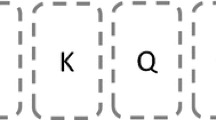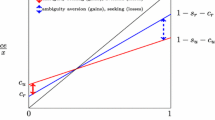Abstract
In this article, ambiguity attitude is measured through the maximum price a decision maker is willing to pay to know the probability of an event. Two problems are examined in which the decision maker faces an act: in one case, buying information implies playing a lottery, while, in the other case, buying information gives also the option to avoid playing the lottery. In both decision settings, relying on the Choquet expected utility model, we study how the decision maker’s risk and ambiguity attitudes affect the reservation price for ambiguity resolution. These effects are analyzed for different levels of ambiguity of the act. Operating instructions for the elicitation of the reservation price for ambiguity resolution in an experimental setting are provided at the end of the article.
Similar content being viewed by others
References
Abdellaoui, M., Baillon, A., Placido, L., & Wakker, P. (2011). The rich domain of uncertainty: Source functions and their experimental implementation. American Economic Review, 5, 101, 695–723.
Ahn, D., Choi, S., Gale, D., & Kariv, S. (2010). Estimating ambiguity aversion in a portfolio choice experiment. Los Angeles: mimeo, University of California.
Andersen, S., Fountain, J., Harrison, G. W., & Rutström, E. E. (2009). Estimating aversion to uncertainty. mimeo, University of Central Florida.
Baillon, A., & Bleichrodt, H. (2010). Are subjective probabilities sign-dependent? mimeo, Erasmus University Rotterdam.
Becker S. W., Brownson F. O. (1964) What price ambiguity? Or the role of ambiguity in decision making. Journal of Political Economy 72: 62–73
Becker G. M., DeGroot M. H., Marschak J. (1964) Measuring utility by a single-response sequential method. Behavioral Science 9: 226–232
Camerer C. F. (1995) Individual decision making. In: Kagel J., Roth A. (eds) Handbook of experimental economics. Princeton University Press, Princeton, pp 587–703
Camerer C., Weber M. (1992) Recent developments in modeling preferences: Uncertainty and ambiguity. Journal of Risk and Uncertainty 5: 325–370
Dominiak, A., & Schnedler, W. (2010). Attitudes toward uncertainty and randomization: An experimental study. mimeo, University of Heidelberg.
Ellsberg D. (1961) Risk, ambiguity and the Savage axioms. Quarterly Journal of Economics 75: 643–669
Fellner W. (1961) Distortion of subjective probabilities as a reaction to uncertainty. Quarterly Journal of Economics 75: 670–689
Ghirardato P. (2004) Defining ambiguity and ambiguity attitude. In: Gilboa I. (Ed.) Uncertainty in economic theory: A collection of essays in honor of David Schmeidler’s 65th birthday. Routledge, London, pp 36–45
Gilboa I., Schmeidler D. (1989) Maxmin expected utility with non-unique prior. Journal of Mathematical Economics 18: 141–153
Halevy Y. (2007) Ellsberg revisited: An experimental study. Econometrica 75: 503–536
Harrison G. W. (1994) Expected utility theory and the experimentalists. Empirical Economics 19: 223–253
Harrison G. W., Rutström E. E. (2008) Risk aversion in the laboratory. In: Harrison G. W., Cox J. (eds) Risk aversion in experiments. JAI Press, Bradford, UK, pp 41–196
Harrison G. W., Rutström E. E. (2009) Expected utility theory and prospect theory: One wedding and a decent funeral. Experimental Economics 12: 133–158
Harrison G. W., Johnson E., McInnes M. M., Rutström E. E. (2007) Measurement with experimental controls. In: Boumans M. (Ed.) Measurement in economics: A handbook. Elsevier, San Diego, CA, pp 79–104
Heath C., Tversky A. (1991) Preference and belief: Ambiguity and competence in choice under uncertainty. Journal of Risk and Uncertainty 4: 5–28
Hey, J. D., Lotito, G., & Maffioletti, A. (2007). Choquet OK? mimeo, University of York.
Hey J. D., Lotito G., Maffioletti A. (2010) The descriptive and predictive adequacy of theories of decision making under uncertainty/ambiguity. Journal of Risk and Uncertainty 41: 81–111
Hey J. D., Orme C. (1994) Investigating generalizations of expected utility theory using experimental data. Econometrica 62: 1291–1326
Holt C. A. (1986) Preference reversal and the independence axiom. American Economic Review 76: 508–515
Ivanov A. (2011) Attitudes to ambiguity in one-shot normal-form games: An experimental study. Games and Economic Behavior 71: 366–394
Izhakian, Y., & Benninga, S. (2008). The uncertainty premium in an ambiguous economy. mimeo, Tel Aviv University.
Karni E., Safra Z. (1987) ‘Preference reversal’ and the observability of preferences by experimental methods. Econometrica 55: 675–685
Klibanoff P., Marinacci M., Mukerji S. (2005) A smooth model of decision making under ambiguity. Econometrica 73: 1849–1892
Knight F. (1921) Risk, uncertainty, and profit. Houghton Mifflin, Boston
Luce, R. D., & Suppes, P. (1965). Preference, utility, and subjective probability. In: R. D. Luce, R. R. Bush, & E. Galanter (Eds.), Handbook of mathematical psychology (Vol. 3, pp 252–410). New York: Wiley.
Maccheroni F., Marinacci M., Rustichini A. (2006) Ambiguity aversion, robustness, and the variational representation of preferences. Econometrica 74: 1447–1498
Maccheroni, F., Marinacci, M., & Ruffino, D. (2010). Robust mean-variance portfolio analysis. Milan: mimeo, Bocconi University.
Machina M. J. (2004) Almost-objective uncertainty. Economic Theory 1: 1–54
Montesano A. (1988) The risk aversion measure without the independence axiom. Theory and Decision 24: 269–288
Montesano A. (1991) Measures of risk aversion with expected and nonexpected utility. Journal of Risk and Uncertainty 4: 271–283
Montesano A., Giovannoni F. (1996) Uncertainty aversion and aversion to increasing uncertainty. Theory and Decision 41: 133–148
Nau R. F. (2006) Uncertainty aversion with second-order utilities and probabilities. Management Science 52: 136–145
Plott C. R., Zeiler K. (2005) The willingness to pay-willingness to accept gap, the ‘endowment effect,’ subject misconceptions, and experimental procedures for eliciting valuations. American Economic Review 95: 530–545
Quiggin J. (2007) Ambiguity and the value of information: An almost-objective events analysis. Economic Theory 30: 409–414
Savage L. J. (1954) The foundations of statistics. Wiley, New York
Schmeidler D. (1989) Subjective probability and expected utility without additivity. Econometrica 57: 571–587
Schoemaker P. (1982) The expected utility model: Its variants, purposes, evidence and limitations. Journal of Economic Literature 20: 529–563
Skiadas, C. (2009). Smooth ambiguity toward small risks and continuous-time recursive utility. mimeo, Northwestern University.
Snow A. (2010) Ambiguity and the value of information. Journal of Risk and Uncertainty 40: 133–145
Starmer C. (2000) Developments in non-expected utility theory: The hunt for a descriptive theory of choice under risk. Journal of Economic Literature 38: 332–382
Wakker P. P. (2010) Prospect theory: For risk and ambiguity. Cambridge University Press, Cambridge, UK
Author information
Authors and Affiliations
Corresponding author
Rights and permissions
About this article
Cite this article
Attanasi, G., Montesano, A. The price for information about probabilities and its relation with risk and ambiguity. Theory Decis 73, 125–160 (2012). https://doi.org/10.1007/s11238-011-9271-6
Published:
Issue Date:
DOI: https://doi.org/10.1007/s11238-011-9271-6
Keywords
- Ambiguity aversion
- Choquet expected utility
- Information about probabilities
- Reservation price for ambiguity resolution
- Option value




